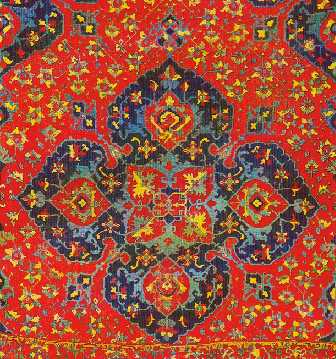| Dear Patrick,
You ask some interesting questions. I'm not sure anyone knows the
answers to them all. Basically, what we know about these embroideries
(Kaitag and Dargin in general, not just this design group) is what Robert
Chenciner learned when he was doing anthropological field work there
around 1990. In a very abbreviated nutshell, it was:
1. There are three
categories - the baby protectors, the dowry wrappers, and the funeral
cloths.
2. Nobody could remember anyone making one of these things, so
probably none had been made since the first quarter of the 20th century,
at the latest.
The dowry wrappers enclosed the bride's dowry as it was transported to
her new home (or to the groom's family home, I don't recall which right
now). The dowry was displayed on the opened wrapper. What happened to the
cloth after that? Since the cloths are still around, we must assume that
they were stored and reused when it was appropriate, most likely within
the same family (perhaps to wrap the dowry of one of the bride's
daughters).
The only basis on which we can guess what a particular piece was used
for is design and color. The very formal examples, which are obviously
derived from formal Ottoman textiles, were dowry wrappers. Those with the
wide palette of bright colors and irregualr drawing were the baby
protectors. Those that might be seen as stylized maps or with figures of
horses were the funereal cloths. The group to which we assign any
individual piece is a judgment call, and subject to the usual
uncertainties of educated guesses.
The first of the four pieces I show, clearly more formal (that is,
drawn with more regularity), is somewhat ambiguous: it could be an
anti-evil eye, or it could be a dowry wrapper. I think it's most likely a
baby protector, mostl ybecause of its resemblance to the other three.
Those are clearly anti-evil eye textiles.
Can we be sure a putative dowry wrapper isn't a representative of some
group other than the three Chenciner listed? I guess we can't be sure, but
since the locals categorized all the embroideries into those groups when
he interviewed them, the default position is that there are no other
groups (at least, until there is some evidence for their existence).
The whole thing is very new - until Chenciner's report few of these
things were known, and they were usually attributed to Uzbekistan. Thus,
what we know is very limited. On the other hand, there isn't a long
history of misinformation about them, either, which helps, as does the
fact that none were produced in response to commercial pressures from the
west, since nobody in the west knew that they existed.
Regards,
Steve Price |




